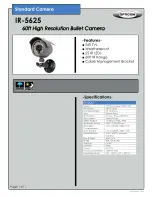
35-3001A-01H Hydrogen Sample-Draw Detector • 5
counterclockwise to increase the flow and clockwise to decrease the flow.
Status LEDs
Two status LEDs are above the flowmeter. They are also visible through the window in the housing
door. The green Pilot LED is on when the sample-draw detector is receiving power from the
controller. The red Fail LED is on when the sample flow rate is below the low flow level.
Pressure Switch
The pressure switch is mounted to the back of the flowmeter circuit board. The pressure switch
monitors the flow rate of the incoming gas sample.
If the flow rate falls below the preset low flow level, the pressure switch causes the Fail LED to
turn on and interrupts the signal from the detector. The interrupted detector signal causes a fail
condition at the controller. The low flow level is factory-set at 0.6 SCFH (±0.1 SCFH). See
“Adjusting the Low Flow Setting” on page 16 to adjust this setting.
Pump Reset Switch
The pump reset switch is located to the left of the status LEDs. When a low flow condition occurs,
the pump will be shut off. To reset the low flow condition and start the pump again, press and hold
the pump reset switch for about 2 seconds, then release.
Hydrophobic Filter
The hydrophobic filter is located toward the bottom left of the main circuit board. The filter
prevents particulates and water in the incoming gas sample from damaging the flow and detection
systems. Replace the filter when it appears dirty, discolored, or clogged.
Pump
The pump is mounted to the right side of the main circuit board. The pump pulls the gas sample
into the sample-draw detector. The pump operates on 24 VAC, which is generated from the 24
VDC supplied by the controller.
Hydrogen Sensor
The catalytic hydrogen sensor detects hydrogen in the %LEL range. It uses a catalytic element for
detection. The reaction of gas with oxygen on the catalyst causes a change in the resistance of the
element which changes the current flowing through it. The current is proportional to the detection
range of the sample-draw detector.
The hydrogen sensor is installed in the flow block and the flow block is mounted to the middle of
the main circuit board. The sensor housing includes a sintered metal flame arrestor on one end that
allows gas to diffuse into the sensor. The sensor has a built in molecular sieve that only allows
hydrogen to diffuse into the detector. On the other end, five pins extend from the sensor and plug
into the socket connector. The connector allows you to replace the sensor without disconnecting the
wiring. Four leads extending from the connector are factory wired to the amplifier.









































